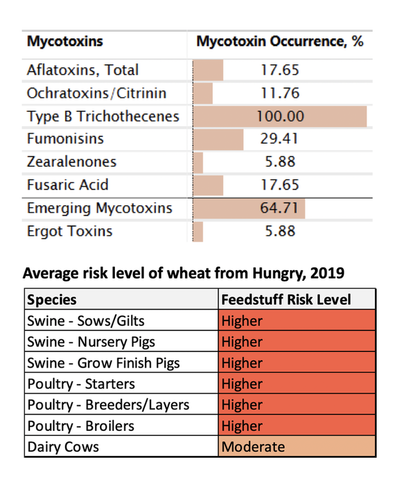European Harvest Analysis Information
HUNGARY:WHEAT
The 2019 wheat harvest samples from Hungary contained an average of 4.0 mycotoxins per sample. The type B trichothecenes family (DON group) were detected in 100% of samples submitted. There was an average level of 1633 ppb in positive samples with a maximum level detected of 7282 ppb in samples. Within this mycotoxin family, deoxynivalenol (DON) was detected in 100 % of samples. Other detected in this sample include 3-acetyl-DON (18%), 15-acetyl-DON (59%) and DON-3-glucoside (47%).
Interestingly, the emerging mycotoxins were also a notable group, with 65% occurrence in samples. Mycotoxins present within this group included enniatinsA/A1 and B/B1 as well as alternariol. Zearalenone, although detected at a lower occurrence and average concentration, could be a risk to pigs as some samples contained up to 88 ppb.
The most significant weather event contributing to mold and mycotoxin production in small grains across Hungary, was surplus rainfall. The rainfall was in surplus May through July and is a major precursor to Fusarium mold growth. Fusarium graminearum is the major producer of Type B Trichothecenes. This mold also can produce zearalenone. Additionally, Fusarium species produce many of the emerging mycotoxins, such as the enniatins.
Poultry breeders/layers: Green < 20;Yellow/Orange 20 - 80;Red > 80
Sows/gilts/boars: Green < 20;Yellow/Orange 20 - 50;Red > 50
Number of samples: 17
Date range: July to September, 2019
VIEW GRAPHICAL SUMMARY
European Harvest Analysis Information
HUNGARY:WHEAT
4
mycotoxins average per sample
100%
contain mycotoxins
1-8
mycotoxins in samples
